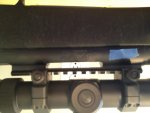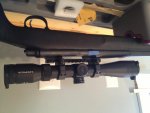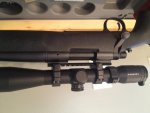I have a Leupold VX-R 3-9x40mm on a 20 MOA base in S-Low TPS rings on a Remington 700 LTR. I've been running this configuration for almost 2 years. I've shot out to 400 yards and never had an issue or knew a "problem/concern" existed.
Last Friday I went out shooting and was able to stretch it out to longer distances. To my surprise, I ran out of elevation at 3.7 mils up from my 100 yard zero. This scope has 60 moa or roughly 17 mils of travel. I double checked the range of elevation and indeed I have about 14 mil of travel down from zero at 100 yards and only 3.7 mils up. This way off from where I though it should be. If anything with a 20 moa rail I should be more on the low side leaving more elevation travel from zero up rather than down.
At this position if I didn't have a 20 moa base the scope would theoretically not zero on a 0 moa base.
My rough calculations indicate I would need at least a 40 moa base to get close to a mechanical zero and a 50 moa base to be able to reach 1000 yards.
Just to clear some obvious questions, I have check all the mounts, torque, removed and re-installed with no effect. The 20 moa base is installed correctly (not backwards).
Something must be off? Has anyone else encounter a similar problem? What was the remedy? More cant like a 30, 40, 50 moa base?
Any help would be appreciated.....
Last Friday I went out shooting and was able to stretch it out to longer distances. To my surprise, I ran out of elevation at 3.7 mils up from my 100 yard zero. This scope has 60 moa or roughly 17 mils of travel. I double checked the range of elevation and indeed I have about 14 mil of travel down from zero at 100 yards and only 3.7 mils up. This way off from where I though it should be. If anything with a 20 moa rail I should be more on the low side leaving more elevation travel from zero up rather than down.
At this position if I didn't have a 20 moa base the scope would theoretically not zero on a 0 moa base.
My rough calculations indicate I would need at least a 40 moa base to get close to a mechanical zero and a 50 moa base to be able to reach 1000 yards.
Just to clear some obvious questions, I have check all the mounts, torque, removed and re-installed with no effect. The 20 moa base is installed correctly (not backwards).
Something must be off? Has anyone else encounter a similar problem? What was the remedy? More cant like a 30, 40, 50 moa base?
Any help would be appreciated.....




